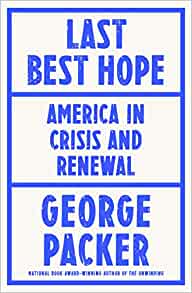I confess to having read a couple of novels this week (The Truth About the Harry Quebert Affair and Tokyo Year Zero) but prior to this, on my travels to and from Italy, I read George Packer’s Last Best Hope: America in Crisis and Renewal. I’d bought it because his big book on US decline, The Unwinding, was so good. This is a short diagnosis of the US as a failed state ending with – despite everything – a positive vision of how to get to the renewal part. In this, Packer casts back to the New Deal and Great Society, particularly some of its relatively unknown architects (Frances Perkins, Bayard Rustin).
It was striking how US-specific the diagnosis is, even though so many of the headwinds are experienced elsewhere – deindustrialisation, geopolitical pressures, demographic and therefore political change, etxreme inequality. I think it is probably because the US is today, like Britain at the start of the 20th century, in such a highly distinctive situation. The same tides are washing over different sandcastles.
One surprise was finding myself sharing a theory of change with Milton Friedman. Quoted here, Friedman wrote: “Only a crisis brings – actual or perceived – produces real change. When that crisis occurs, the actions that are taken depend on the ideas that are lying around. That I believe is our basic function: to develop alternatives to existing policies, to keep them alive and available until the politically impossible becomes the politically inevitable.”
Anyway, Last Best Hope explores previous crises in order to identify what alternatives might now reduce divisions and restore democracy in the US. For all that Packer tries to end on an upbeat note, I’m not sure I believe this is possible. For those of us who grew up with the positive vision of American dynamism, egalitarianism, and opportunity (alongside all its obvious terrible flaws), this is pretty depressing. As Adam Tooze concludes his excellent new book, Shutdown (which I’ve reviewed for Democracy, due to be online soon), history has come for us all.

